Poplar genus or Populus.
Finding out what Poplar species you are dealing with.
Finding out what Poplar species you are dealing with can be a real nuisance. Books that give keys differ from each other when you try to look up a specific tree. Photographs on the internet contradict. This all has to do probably by the high-cultivation factor of these "production" species. Because of inter-breeding species are often more like races, that can and do cross-breed. More often then not poplars are planted and are not "wild". For Dutch people I'd like to refer to a good review of cultivation races in the Netherlands in [5].
Here some guidance to determine what species a Poplar tree belongs to but please let yourself be guided by looking at the photo's as your main source.
You can divide the Dutch Poplars into two main groups: the white/grey poplar and the Aspen, and as second group the Eastern cottonwood/Carolina Poplar/Lombardy poplar. Besides the members of those groups there are some more poplars.
According to our elimination principle first the species that are easy to spot:
1. Is the tree column-shaped? -> Lombardy poplar. . This is a mutation of the Populus nigra where the branches are very right-up, giving it a columnar shape. All Lombardy poplars are clones from one male individual and therefore are always planted. Leafs look like the ace of spades.
2. Poplars that have a similar leaf as the lombardy poplar, but that are not column-shaped are in the Eastern cottonwood/Carolina Poplar/Lombardy poplar group. Often very tall trees with an indistinct crown: just some branches that stick out of a tall tree like a fish-bones coming from the spine of a fish. The trunk, possibly from 2 meters above the ground but also possibly from upto tens of meters, has shiny patches of grey/smooth bark. Leafs in the form of the ace of spades. The petiole (peace of wood that connects the leaf to the twig) is "flat" like a straw that has been squashed. Therefore the leafs make a sound in the wind. The twigs come off easily in the wind: often there are many twigs on the ground beneath the tree. They grow very very tall and fast. Bark is rough to very rough. Often they are planted in the polder. Seed looks like cotton: that's why the name cottonwoods.
3. Trunk is notoriously grey/whitish, a bit like a Birch but differently, from the ground up whitish or maybe from a meter or two up: a white/grey poplar or Aspen.
The Aspen has a white trunk form the ground up with barely any real rough bark. Leafs are all alike: pretty round with lobes (look at the pics and you will immediately recognize it). Big Aspen look like the Carolina group above because they are tall high trees without a real crown. The bark has star-formed "holes" in it you can't miss.
If the bark is white-ish almost directly form the ground up (with sometimes parts dark rough bark, often only at one side of the tree), but the leafs are different form the Aspen, and the leafs are not white at the bottom and do not reflect light it is probably a Grey poplar. The grey poplar as a species is a cross-fertilization between the Aspen and the white poplar. In characteristics it stands between these two species. Offspring of the grey polar often do have leafs that are white on the bottom and reflect light. The grey poplar is not as tall as other poplars and has more or less a round crown when it stands alone. The leafs are very variable with lobes and can be from very small with unclear lobes to the size of a hand with clear lobes/fingers like a maple-leaf.
If the tree looks like a grey poplar, but the leafs are clearly white-ish on the bottom and they reflect light and the surface feels/looks like felt it is a White poplar.. You can often recognize these from quite a long distance away (treespotting from quite a long distance away, see Monthy Python) because the crown reflects light. Leafs on the end of twigs look in shape like maple leafs. Leafs at the basis of twigs are smaller, have a less distinct form and are less felty at the bottom.
All three species, White/Grey poplar and Aspen have petioles (the piece of wood that connects the leaf to the twig it is on) that are flattened.
When a tree looks like a poplar but it does not fit the descriptions given above, the petiole is not flat, there are still a number of species that are possible.
Another possibility is the Populus balsamifera of Balsam Poplar: if the petiole is not flattened sideways and the leaf is pretty big and non-lobed and heart-shaped. (3). This species is said to have sticky buds that smell like balsem. A photograph can be found here
Here is another key to figure out what kind of poplar you are dealing with.
All photographed poplar species.
Grey poplar or Populus canescens
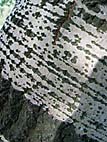



 White poplar or Populus alba
White poplar or Populus alba




 Carolina poplar or Populus x canadensis (cross-fertilazation of P deltoides en P nigra)
Carolina poplar or Populus x canadensis (cross-fertilazation of P deltoides en P nigra)




 Balsam populier or Balsam poplar
Balsam populier or Balsam poplar
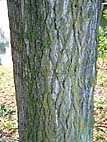
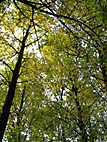
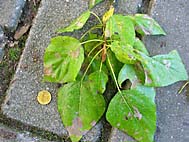
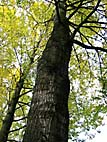 Eastern cottonwood; Eastern poplar or Populus deltoides
Eastern cottonwood; Eastern poplar or Populus deltoides

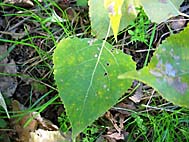

 Lombardy poplar or Populus nigra
Lombardy poplar or Populus nigra



 Aspen or Populus tremula
Aspen or Populus tremula


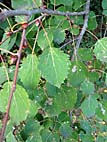

All leafs of photographed poplars.
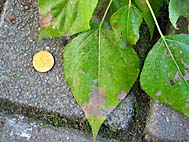


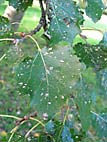










Winter photo's of bark and buds, if available.



Volgend individu / next individual




Volgend individu / next individual


Volgend individu / next individual



Volgend individu / next individual


